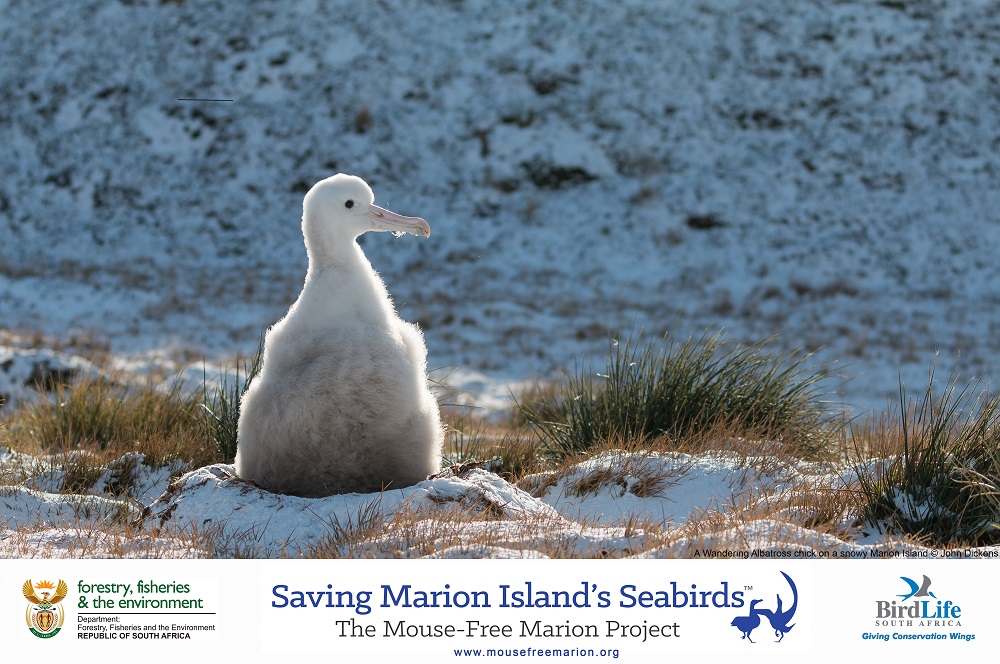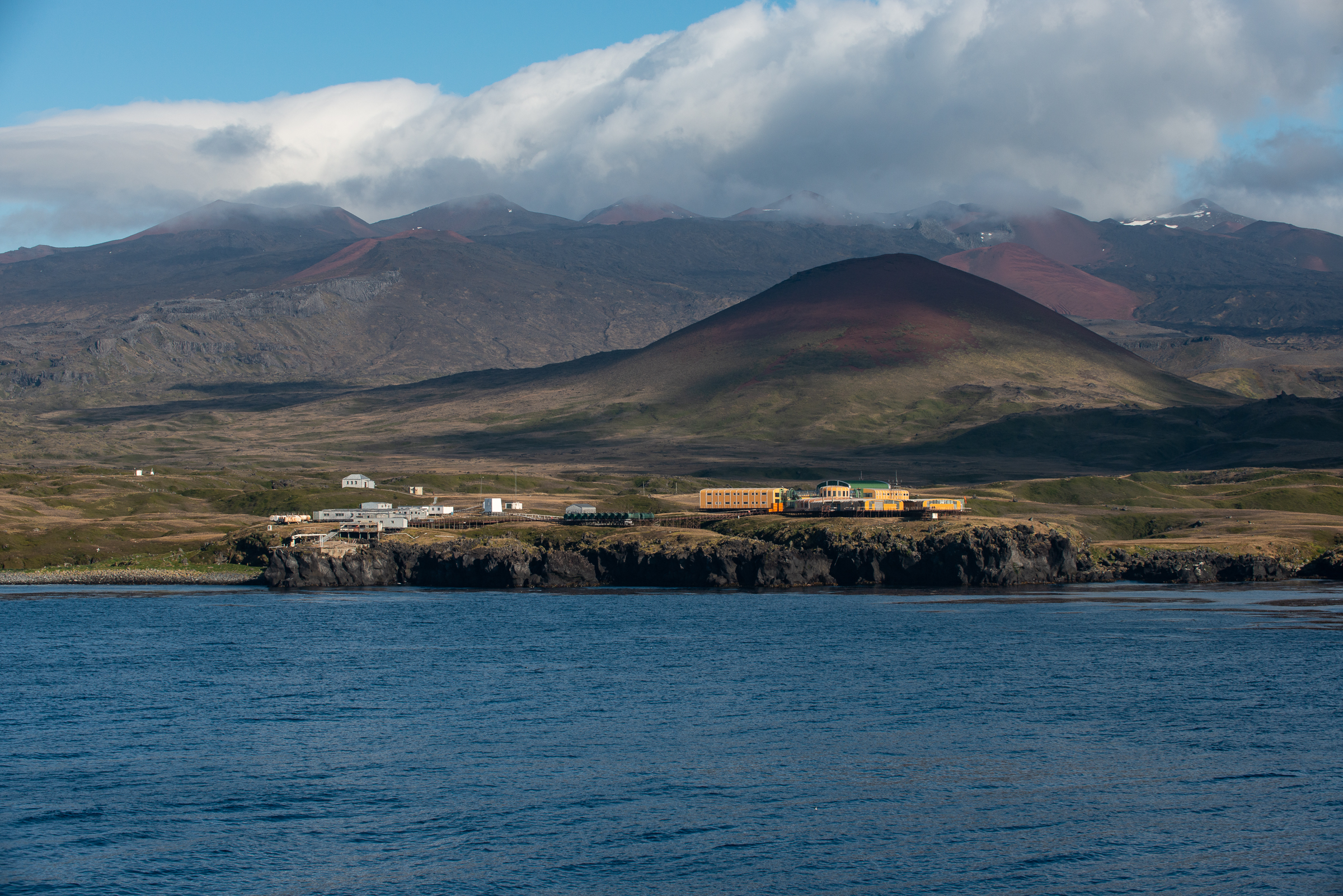
A Wandering Albatross chick at risk to Marion’s mice; photograph by John Dickens, poster design by Michelle Risi
NOTE: The Mouse-Free Marion Project is working towards eradicating the island’s introduced House Mice Mus musculus which attack and kill albatrosses and other seabirds. In this guest post marking World Albatross Day on 19 June, the MFM Project Manager, Dr Anton Wolfaardt, describes how restoring Marion’s ecological integrity affected by climate change is an important stimulus behind the eradication.

Anton Wolfaardt on the cliffs above Marion Island’s south coast in 2021, close to where Grey-headed Albatross chicks face the onslaught of mice every year
photograph by Leandri de Kock
Marion Island is an awe-inspiring place. This windswept and remote outpost, located in the southern Indian Ocean roughly halfway between Cape Town and Antarctica, is home to a wealth of seabirds and marine mammals. Marion is the larger of the two islands that together comprise the Prince Edward Islands group, which in turn forms part of a ring of sub-Antarctic islands that rise from the floor of the Southern Ocean around Antarctica. Given the sparsity of these islands in the extensive and highly productive Southern Ocean, they contain many riches of the natural world. They are particularly important for seabirds and seals, who, although spending most of their time at sea, must return to land to breed. With few places to choose from, these sub-Antarctic islands are havens for an abundance of wildlife, hosting spectacular congregations of seabirds.

The meteorological/research station on Marion Island on a rare good-weather day, photograph by Anton Wolfaardt
Marion and Prince Edward Island are no exception. The volcanic sand beaches, rocky outcrops, cliff faces, and grassy hills of Marion Island are home to 28 seabird species, including nine albatross and petrel species listed by the Agreement on the Conservation of Albatrosses and Petrels (ACAP). The two islands collectively support almost half of the world’s Vulnerable Wandering Albatrosses Diomedea exulans, with Marion alone hosting a quarter of the global population.
Given the global importance of the Prince Edward Islands for seabirds and other wildlife, the island group was declared a Special Nature Reserve by the South African Government in 1995. This is the highest level of protection afforded under South African legislation. As the country’s only declared Special Nature Reserve, the Prince Edward Island group is arguably the jewel in the crown of South Africa’s protected area network.

A House Mouse feeds on the exposed scalp of a Wandering Albatross chick at night on Marion Island; the bird did not survive, photograph by Stefan Schoombie
Unfortunately, Marion Island is no longer the safe haven that it used to be. House Mice, accidentally introduced by humans early in the 19th century, have had a devastating impact on the ecology of the island. Mice are highly adaptable and voracious omnivores that reproduce rapidly and can eat almost anything in such quantity that they can alter ecological processes and drive an island into a state of ecological impoverishment.
The impacts of mice on Marion Island’s ecology are widespread, pervasive, extreme and highly deleterious. The native invertebrate fauna has been particularly hard hit, with several species reduced to tiny proportions of their pre-mouse populations, altering nutrient cycling and other key ecological processes. Mice also impact vegetation, greatly reducing seed production and seriously damaging keystone species, such as the cushion plant Azorella selago.
These ecological impacts have been greatly exacerbated by climate change. Marion Island’s climate is changing rapidly, with a significant reduction in rainfall and an increase in temperature of more than 1°C over the last 30 years. This warmer and drier climate has contributed to a substantial increase in the densities of mice on the island each summer, causing a shortage of invertebrates upon which the mice have been surviving over the winter months. This shortage of food has driven mice to find alternative food sources, which they have found in the form of naïve seabirds. As on several other oceanic islands, the mice found many of the seabirds had no defence against their attacks. They are literally “sitting ducks”.
The scale and frequency of attacks on seabirds have been increasing since they were first observed in the early 2000s. Mice currently kill up to 5-10% of albatross chicks each year, and this rate of mortality is expected to get worse as climate change facilitates increasing densities of mice each summer. Left unchecked on Marion Island, the mice are likely to cause the local extinction of 18 of the 28 seabird species that breed on the island.

This Light-mantled Albatross chick has also been scalped by mice, photograph by Peter Ryan
The Mouse-Free Marion (MFM) Project is a collaborative conservation initiative working towards eradicating the invasive mice from Marion Island. This will be done through the aerial application of rodenticide bait – the only approach that has proven successful on large oceanic islands. In addition to the formal partnership between the South African Department of Forestry, Fisheries and the Environment (DFFE) and the environmental NGO BirdLife South Africa to undertake the project, there are a number of other organisations engaged in and helping to progress this endeavour.

ACAP and the MFM Project have collaborated to produce this infographic to mark World Albatross Day 2022; one in a growing series to be found on the ACAP website
Restoring the ecology of Marion Island, including its impressive seabird assemblage, will have permanent and significant conservation benefits, and will help mitigate the impacts of other threats, such as climate change. The removal of introduced predators from islands is one of the most effective and tractable conservation interventions. We know from operations that have preceded ours that once introduced predators have been removed from islands, the ecological recovery and rebounding of affected populations can be truly spectacular. We can achieve this outcome for Marion Island.

Hoping for a restored island: a Wandering Albatross pair interact near a research laboratory on Marion Island, photograph by Stefan Schoombie, poster design by Michelle Risi
There remains a lot to do before we undertake the actual baiting operation, not least the need to raise the outstanding funding required. We are working hard to ensure that the MFM Project has the best chance of success. Eradicating mice from Marion Island will provide an incredible conservation legacy, one which will enable the island group to rightly claim its title of being the jewel in the crown of South Africa’s protected area network.
Your support can help us achieve this outcome. For more information on the MFM Project and ways to support it (and to download the collection of posters), please visit our website.
Editorial thanks to Michelle Risi for poster design, Namo Niumim for infographic work, and all the photographers.
Dr Anton Wolfaardt, Mouse-Free Marion Project Manager, 16 June 2022

 English
English  Français
Français  Español
Español